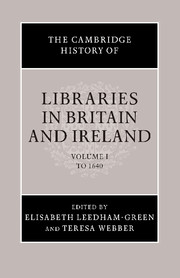Book contents
- Frontmatter
- Introduction
- The physical setting
- Part One The medieval library
- 2 Celtic Britain and Ireland in the early middle ages
- 3 Anglo-Saxon England
- 4 Monastic and cathedral book collections in the late eleventh and twelfth centuries
- 5 The libraries of religious houses in the late middle ages
- 6 College and university book collections and libraries
- 7 Bishops and kings: private book collections in medieval England
- 8 The medieval librarian
- 9 Borrowing and reference: access to libraries in the late middle ages
- Part Two Reformation, dissolution, new learning
- Part Three Tools of the trade
- Part Four Libraries for leisure
- Part Five Organisation and administration
- Select bibliography
- General index
- Index of manuscripts
- References
3 - Anglo-Saxon England
from Part One - The medieval library
Published online by Cambridge University Press: 28 March 2008
- Frontmatter
- Introduction
- The physical setting
- Part One The medieval library
- 2 Celtic Britain and Ireland in the early middle ages
- 3 Anglo-Saxon England
- 4 Monastic and cathedral book collections in the late eleventh and twelfth centuries
- 5 The libraries of religious houses in the late middle ages
- 6 College and university book collections and libraries
- 7 Bishops and kings: private book collections in medieval England
- 8 The medieval librarian
- 9 Borrowing and reference: access to libraries in the late middle ages
- Part Two Reformation, dissolution, new learning
- Part Three Tools of the trade
- Part Four Libraries for leisure
- Part Five Organisation and administration
- Select bibliography
- General index
- Index of manuscripts
- References
Summary
Although there were libraries in Roman Britain, there is very little evidence for any continuity between them and the books owned by the Anglo-Saxons. In the Anglo-Saxon era books were assembled at various places for various reasons, but evidence for these collections and their contents is usually lost. The largest collections belonged to religious communities, especially in monasteries or cathedrals, but most evidence for the rules and customs of such communities dates from after the Norman Conquest. We have several detailed twelfth-century booklists, which may include pre-Conquest holdings. But for the five centuries before 1066 neither archaeology, history nor literary investigation can supply many certainties about what libraries may have been. The written evidence from this period does not define the scope or purpose of a library, or distinguish clearly between the various functions of books or collections of books. It therefore seems appropriate in this chapter to use the term ‘library’ in its most general sense to refer collectively to the books possessed by a community or individual.
Any account of Anglo-Saxon libraries must first consider the Anglo-Saxon terminology in Latin and Old English. Arca libraria, the solution to Aldhelm’s riddle 89, refers to a chest in which books were kept; few Anglo-Saxon libraries can be shown to have been larger than one or two such chests of books. The Old English equivalent is bocciste or boccest. Armaria (‘chest’ or ‘cupboard’) is glossed as boccysta in an eleventh-century Old English gloss to Augustine’s Enchiridion in Cambridge, Trinity Coll., MS O.1.18, 2 and also in a few narrative texts.
- Type
- Chapter
- Information
- The Cambridge History of Libraries in Britain and Ireland , pp. 91 - 108Publisher: Cambridge University PressPrint publication year: 2006
References
- 44
- Cited by



